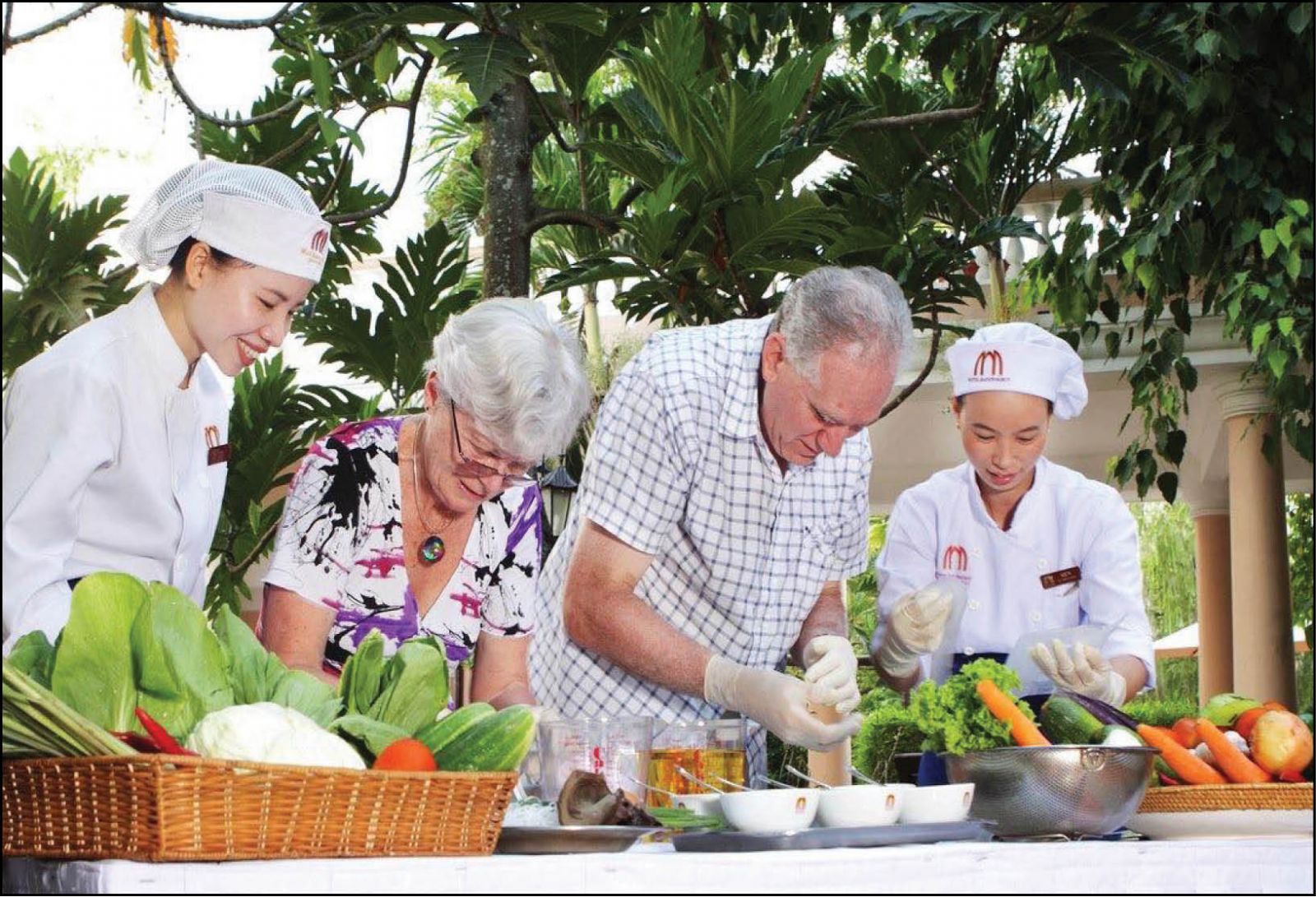
Guests experiencing Hue food processing. Photo: Saigon Morin Hotel
Ngu Yen (Royal Feast) Restoration
At the Hue Festivals, Hue Monuments Conservation Center in collaboration with the culinary artist Ho Thi Hoang Anh and Duy Tan Hotel organized Royal Feasts in Imperial Palace in the Royal Night Program. This is an effort of those dedicated to preserving and restoring Hue royal cuisine, from raw materials, processing and presentation to venue.
With dishes, such as: Quarter – pickled vegetables, sea cucumber cooked with shrimp and vegetables, Hue chicken salad, steamed duck - sticky rice, purple taro cake and millet cake, painted enamel colored cake, ... the Royal Feast recreated the scene of the king setting a feast for the royal courts. These were elaborately and delicately processed dishes in accordance with the materials and formulas of the royal family in the past.
In the space of the old court party with sparkling candles, elegant music and royal dances, diners understood clearly the sophistication and elaboration in creating each dish that the king used to treat his guests.
After the festival, the miniature palace night program continues to be held at Duyet Thi Duong Theater to serve high-class tours. "Ngu Yen" (Royal Feast) has become a unique tourist product of Hue.
With folk cuisine, in addition to famous specialties, such as mussel rice, beef noodle..., Hue meals with daily dishes: boiled pork with pickled shrimp, braised goby fish, spicy and sour soup or mix-vegetable soup ... also please guests who have the opportunity to visit the ancient capital. Wanting to eat well, Hue people often have seasonal rules. They prepare dishes according to season and create dishes which are both delicious and healthy.
Tieu Kieu, a culinary artist, pointed out some seasonal products of Hue people: February and October are the seasons of delicious fresh shrimp to cook with gourd and vegetable soup. April to June is the season for meat crabs to be eaten salted, roasted with tamarind, steamed or in crab noodle soup.
In July and August in Hue, there are white-spotted rabbitfish, tiger perch, and mullet fish, which are delicious and fat. November and December are the time for buying flood fish. Sour bamboo shoots cooked with delicious cranoglanis fish is truly an unforgettable dish.
From March to September is the season of Cồn corn with even kennels, perfect for cooking fragrant, supple sweet corn soup. In June and July, lotus seeds are picked. They are delicious and nutritious to cook lotus rice, lotus wrapped with longan sweet soup...
Building the right menu
To bring Hue back to the position of a culinary capital, it is necessary to create an institutional system, a restaurant, a center for visitors to experience and enjoy. At the same time, it is necessary to gather people who are interested, capable and have research capability to gradually restore typical dishes.
According to Nguyen Dac Xuan, the researcher, if we could not recover 1,700 Hue dishes, we should consider studying 170 or at least 17 dishes including savory, vegetarian, appetizer, dessert, snacks...
Dr. Han Nguyen Nha, former Director of the Vietnam Culinary Research Institute, called for a menu of typical royal and folk dishes to promote over the world.
For example, appetizers include fig salad, Thanh Tra pomelo salad, lotus salad. The snack dish includes mussel, venison, abalone, grilled pork patties on sugarcane, peacock spring rolls, phoenix pork rolls, and etc. The main dishes include braised pork and shrimp, white-spotted rabbitfish soup, steamed rice wrapped in lotus leaf… In addition, there are also soups, cakes, desserts, and vegetarian dishes ...
The culinary quintessence of Hue can be considered as the most unique in the "The food of heaven", a special Hue culinary curriculum, which was created by a famous royal family of Hue. It needs to be reproduced into Hue meals, even considering copyright registration, to allow the "The food of heaven" to come alive in today's society.
In Lac Tinh Vien, there is a story of cultural history through time, with a culinary heritage associated with talented women, which can turn it into a tourist destination. To enjoy staying at a homestay, eating Hue meals, and interacting with the owners is a unique experience of guests.
Tran Dinh Hang, a researcher, Head of the Vietnam National Academy of Arts and Culture in Hue, said: “We have approached and re-created the culinary culture in the work "The food of heaven" in the way of: analyzing the processing materials, the way to prepare dishes from a pharmacological perspective of modern medicine and traditional oriental medicine. From the subjective opinion of historical, cultural researchers and especially culinary experts, culinary artisans, we will propose to build some menus to serve in festive spaces and to build a detailed and unique set of Hue culinary curriculum”.
It is crucial to determine the concepts, criteria and objects associated with each space and each specific level of Hue culinary culture with the convergence and spreading nature of a (former) capital city.
Dr. Tran Dinh Hang emphasized that the court's culinary culture, the aristocracy, the folk, or vegetarian cuisine ... must be isolated to conduct surveys and build databases, with sufficient arguments and facts (historical data, actual investigations, etc.).
On the basis of traditional data, culinary experts would have enough evidence to create menus suitable for specific spaces, serving specific audiences.
From a typical Hue culinary menu, there will be many appropriate versions, optimally serving the diverse needs of life. However, they must ensure that the spirit of Hue cuisine remains: clean, with many nutritional, medical and spiritual values, delicate, and elegant.
By Minh Hien